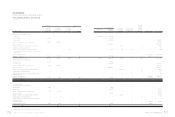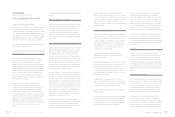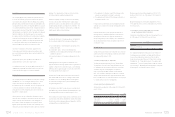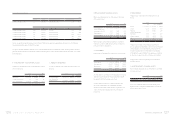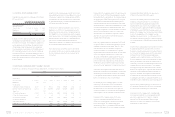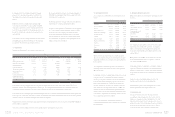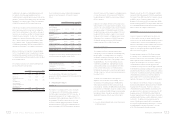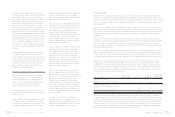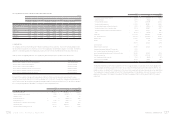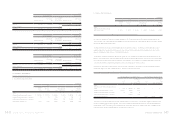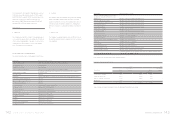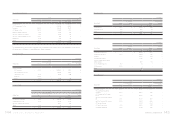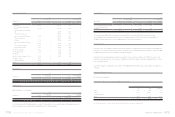HTC 2010 Annual Report Download - page 68
Download and view the complete annual report
Please find page 68 of the 2010 HTC annual report below. You can navigate through the pages in the report by either clicking on the pages listed below, or by using the keyword search tool below to find specific information within the annual report.
134 2 0 1 0 H T C A N N U A L R E P O R T 135
FINANCIAL INFORMATION
The capital surplus from long-term equity investments was
NT$17,534 thousand as of January 1, 2009. When the Company
did not subscribe for the new shares issued by Vitamin D
Inc. in January 2009 and June 2009, adjustments of NT$187
thousand and NT$484 thousand were made to the investment
carrying value and capital surplus, respectively. In December
2009, the Company also determined that the recoverable
amount of this investment was less than its carrying amount
and recognized an impairment loss on its carrying value. As a
result, the carrying value of this investment became zero and
the Company reversed a capital surplus of NT$2,360 thousand
that was recognized in prior years for the movement of Vitamin
D’s capital surplus in proportion to the Company’s equivalent
stock. The Company also recognized the movement of other
investees’ capital surplus amounting to NT$2,566 thousand. As
of December 31, 2010, the total capital surplus from long-term
equity-method investments was NT$18,411 thousand (US$632
thousand).
The additional paid-in capital from a merger was NT$25,756
thousand as of January 1, 2009. In January 2009, November
2009 and April 2010, the retirement of treasury stock caused a
decrease of additional paid-in capital from a merger amounted
to NT$341 thousand, NT$226 thousand and NT$479 thousand
(US$17 thousand), respectively. As a result, the additional
paid-in capital from a merger as of December 31, 2010 was
NT$24,710 thousand (US$848 thousand).
Appropriation of Retained Earnings and Dividend Policy
Based on the Company Law of the ROC and the Company’s
Articles of Incorporation, 10% of the Company’s annual net
income less any deficit should first be appropriated as legal
reserve. From the remainder, there should be appropriations
of not more than 3‰ as remuneration to directors and
supervisors and at least 5% as bonuses to employees.
The appropriation of retained earnings should be proposed
by the board of directors and approved by the stockholders in
their annual meeting.
As part of a high-technology industry and a growing enterprise,
the Company considers its operating environment, industry
developments, and long-term interests of stockholders as well
as its programs to maintain operating eciency and meet its
capital expenditure budget and financial goals in determining
the stock or cash dividends to be paid. The Company’s
dividend policy stipulates that at least 50% of total dividends
may be distributed as cash dividends.
The bonus to employees of NT$6,164,889 thousand for 2008
were approved in the stockholders’ meeting in June 2009. The
bonus to employees included a cash bonus of NT$1,210,000
thousand and a share bonus of NT$4,954,889 thousand. The
number of shares of 13,357 thousand was determined by
dividing the amount of share bonus by the closing price (after
considering the eect of cash and stock dividends) of the
shares of the day immediately preceding the stockholders’
meeting. The approved amounts of the bonus to employees
were the same as the accrued amounts.
The bonus to employees of NT$4,859,236 thousand for 2009
were approved in the stockholders’ meeting in June 2010. The
bonus to employees included a cash bonus of NT$2,915,542
thousand and a share bonus of NT$1,943,694 thousand. The
number of shares of 5,021 thousand was determined by
dividing the amount of share bonus by the closing price (after
considering the eect of cash and stock dividends) of the
shares of the day immediately preceding the stockholders’
meeting. The approved amounts of the bonus to employees
were the same as the accrued amounts.
Based on a resolution passed by the Company’s board of
directors, the employee bonus for 2009 and 2010 should be
appropriated at 18% of net income before deducting employee
bonus expenses. If the actual amounts subsequently resolved
by the stockholders dier from the proposed amounts,
the dierences are recorded in the year of stockholders’
resolution as a change in accounting estimate. If bonus shares
are resolved to be distributed to employees, the number of
shares is determined by dividing the amount of bonus by the
closing price (after considering the eect of cash and stock
dividends) of the shares of the day immediately preceding the
stockholders’ meeting.
As of January 18, 2010, the date of the accompanying
independent auditors’ report, the appropriation of the 2010
earnings had not been proposed by the Board of Directors.
Information on earnings appropriation can be accessed online
through the Market Observation Post System website.
19. TREASURY STOCK
On October 7, 2008, the Company’s board of directors passed a resolution to buy back 10,000 thousand Company shares from the
open market. The repurchase period was between October 8, 2008 and December 7, 2008, and the repurchase price ranged from
NT$400 to NT$500 per share. If the Company’s share price was lower than this price range, the Company might continue to buy back
its shares. The Company bought back 10,000 thousand shares for NT$3,410,277 thousand during the repurchase period and retired
them in January 2009.
On July 31, 2009, the Company’s board of directors passed a resolution to buy back 13,000 thousand Company shares from the open
market. The repurchase period was between August 3, 2009 and October 2, 2009, and the repurchase price ranged from NT$300 to
NT$500 per share. If the Company’s share price was lower than this price range, the Company might continue to buy back its shares.
The Company bought back 7,085 thousand shares for NT$2,406,930 thousand during the repurchase period and retired them in
November 2009.
On February 9, 2010, the Company’s board of directors passed a resolution to buy back 15,000 thousand Company shares from the
open market. The repurchase period was between February 10, 2010 and April 9, 2010, and the repurchase price ranged from NT$280
to NT$500 per share. If the Company’s share price was lower than this price range, the Company might continue to buy back its
shares. The Company bought back 15,000 thousand shares for NT$4,834,174 thousand (US$165,951 thousand) during the repurchase
period and retired them in April 2010.
On July 11, 2010, the Company’s board of directors passed a resolution to buy back 10,000 thousand Company shares from the open
market. The repurchase period was between July 13, 2010 and September 12, 2010, and the repurchase price ranged from NT$526 to
NT$631 per share. If the Company’s share price was lower than this price range, the Company might continue to buy back its shares.
The Company bought back 4,786 thousand shares for NT$2,865,990 thousand (US$98,387 thousand) during the repurchase period.
On October 29, 2010, the Company’s board of directors passed a resolution to buy back 10,000 thousand and 10,000 thousand
Company shares from the open market between November 1, 2010 and November 30, 2010, and between December 1, 2010 and
December 31, 2010, respectively, with the repurchase price ranging from NT$565 to NT$850 per share. If the Company’s share price
was lower than this price range, the Company might continue to buy back its shares. The Company bought back 5,000 thousand
shares for NT$3,986,503 thousand (US$136,852 thousand) during the repurchase period. The related treasury stock information for
the years ended December 31, 2009 and 2010 was as follows:
(In Thousands of Shares)
Purpose of Treasury Stock
Number of Shares,
Beginning of Year
Addition
During the Year
Reduction
During the Year
Number of Shares,
End of Year
Year ended December 31, 2009
To maintain the Company’s credibility and shareholders’
interest 10,000 7,085 17,085 -
Year ended December 31, 2010
To maintain the Company’s credibility and shareholders’
interest - 15,000 15,000 -
For transferring shares to the Company’s employees - 9,786 - 9,786
- 24,786 15,000 9,786
Based on the Securities and Exchange Act of the ROC, the number of reacquired shares should not exceed 10% of the Company’s
issued and outstanding stocks, and the total purchase amount should not exceed the sum of the retained earnings, additional paid-in
capital in excess of par, and realized capital reserve. In addition, the Company should not pledge its treasury shares nor exercise voting
rights on the shares before their reissuance.Based on the Securities and Exchange Act of the ROC, the number of reacquired shares
should not exceed 10% of the Company’s issued and outstanding stocks, and the total purchase amount should not exceed the sum
of the retained earnings, additional paid-in capital in excess of par, and realized capital reserve. In addition, the Company should not
pledge its treasury shares nor exercise voting rights on the shares before their reissuance.



